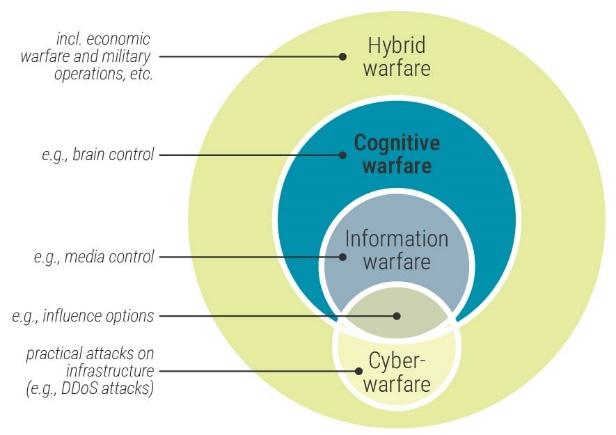Introduction
Defining cognitive warfare in the digital context
In the hidden corners of our connected world, a new type of conflict is taking shape, unseen yet powerful. Cognitive warfare, which uses digital tech and mind games, is becoming a real threat to our national security and how our society functions.
We've moved from simply controlling information to something more complex. It's about cleverly influencing how people and groups react to that information. This shift to cognitive warfare is a big deal. It uses cutting-edge tech and psychological tricks to sway decision-making processes within societies and military structures.
The rise of cognitive warfare is closely tied to technological advancements, particularly in artificial intelligence and data analytics. These tools enable adversaries to launch sophisticated campaigns that manipulate perceptions, sway public opinion, and potentially disrupt military operations.
Critical Components of Cognitive Warfare
Decision-making interference Cognitive warfare targets the mental processes behind critical thinking and decision-making. Tactics include exploiting cognitive biases, overwhelming information, and spreading misinformation to create confusion. New technologies like AI and synthetic media have increased the potential for sophisticated interference with decision-making online.

Perception manipulation Cognitive warfare aims to change how people or groups see reality, influencing their choices. This happens through spreading false information, mind games, and using advanced tech like deepfakes. The attacker wants to twist how the target sees events or facts, matching the attacker's goals. This warps the target's actions and decisions.
Emotional exploitation Cognitive warfare targets emotions to sway decisions and actions. This involves using emotionally charged content, fear tactics, and exploiting psychological weak points. Advanced Tech like AI and machine learning now analyze vast emotional data, enabling more precise and targeted manipulation campaigns.
Common Tactics and Techniques in Cognitive Warfare
Information operations and disinformation campaigns Digital platforms are used to spread false or misleading information on a large scale. These efforts often use social media algorithms to create "information bubbles," isolating people in echo chambers that reinforce specific narratives. The impact of these operations is increased by collecting and analyzing large amounts of personal data, allowing content to be tailored to individual mindsets and emotional states.
In 2016, Cambridge Analytica, a data analytics firm, obtained personal information from millions of Facebook users without proper authorization. They didn't just sit on this data; they used it to craft detailed psychological profiles and bombard voters with tailored political messages during the U.S. presidential election.
This eye-opening incident pulled back the curtain on how social media platforms could be manipulated. It revealed a troubling reality: when combined with sophisticated analysis and precision-targeted content delivery, vast amounts of personal data could sway public opinion and tip the scales in an election.
The threat of Artificial Intelligence and Machine Learning in cognitive warfare
AI and ML systems can now independently create and spread targeted content, greatly expanding cognitive warfare capabilities. These tools produce convincing fake videos and other artificial media, making it harder to distinguish truth from fiction in the information space.
Cognitive warfare tactics often target critical infrastructure and decision systems to disrupt vital services and weaken social stability. These attacks may exploit weak points in industrial controls, communication networks, or financial systems, causing widespread failures across multiple sectors. The interconnected nature of modern infrastructure increases the potential damage from such operations, requiring robust cybersecurity and resilience measures.
Cognitive warfare threats now use advanced tactics and tech to exploit mental weaknesses and shape public opinion. A key concern is "algorithmic cognitive warfare," which uses AI algorithms to analyze, track, and sway target groups with high precision. This method allows enemies to pinpoint individuals based on their online activity, using personal data and behavior to craft persuasive messages that strongly influence decision-making.
Future Directions in Cognitive Warfare Defense
As cognitive warfare techniques advance, Unissant remains committed to pushing the boundaries of defense capabilities. Future developments may include:
- Integration of quantum computing for enhanced pattern recognition and threat prediction
- Development of AI-driven, autonomous defense systems capable of real-time response to cognitive attacks
- Creation of immersive virtual reality training environments to simulate complex cognitive warfare scenarios
- Advancement of neurological interfaces to enhance human cognitive capabilities in high-stress decision-making situations
The evolving nature of cognitive warfare necessitates international collaboration to develop and implement effective countermeasures. Integrating artificial intelligence-powered detection systems and shared threat intelligence platforms can facilitate swift identification and mitigation of coordinated disinformation efforts across multiple spheres.
Venture Capital Investments in Cognitive Warfare
As cognitive warfare gains prominence in national security and global competition, venture capital firms are pouring money into startups and technologies tackling this emerging threat landscape. These investments cut across various fields, including AI, machine learning, cybersecurity, and data analytics. It's fascinating to see how the invisible battlefield shapes the focus of tech investments. We're witnessing a shift where the power of information and cognition is becoming just as crucial as traditional military might. This trend raises intriguing questions about the future of defense technology and its implications for global security dynamics.
With the rise of deepfakes and other synthetic media, investors are backing companies that are developing advanced detection technologies. These companies are creating solutions to identify and flag manipulated content, helping maintain the integrity of information ecosystems.
As the cognitive warfare landscape continues to evolve, venture capital investments in these areas will likely grow, driving innovation and the development of new technologies to counter emerging threats.
References
Chinese Communist Party (CCP) Central Propaganda Department. (2021). Questions and Answers for the Study of Xi Jinping Thought on Socialism with Chinese Characteristics for a New Era (1st ed., pp. 42–46).
(2020). Global R&D and a New Era of Alliances | Center for Security and Emerging Technology. In Georgetown. https://cset.georgetown.edu/publication/global-rd-and-a-new-era-of-alliances/
(2024). SPECIAL COMPETITIVE STUDIES PROJECT. Unknown.
Nikoula, D., & McMahon, D. (2024). Cognitive Warfare: Securing Hearts and Minds. Laboratoire sur Integrity de Information Ottawa Information Integrity Lab.


